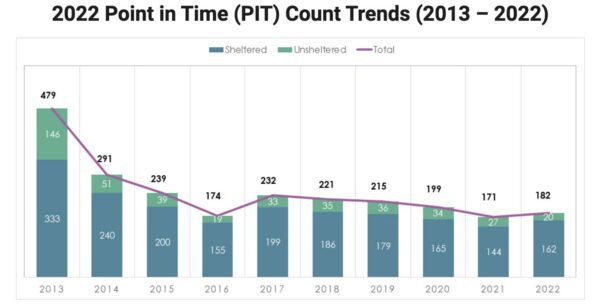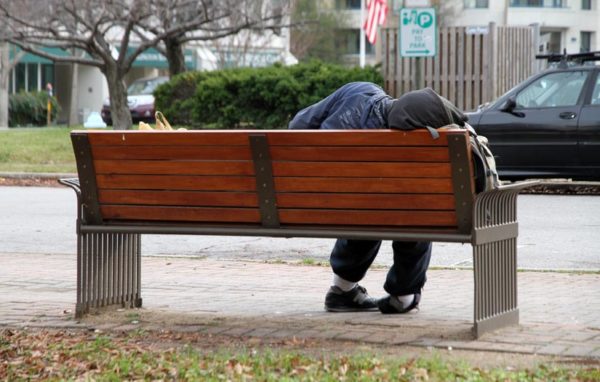
What can we do to help those in our community who are experiencing homelessness is a question Triina Van gets a lot.
Van has been Homeless Services Coordinator at Arlington County’s Department of Human Services for about a year and a half. But she has more than two decades of experience working in the field and thinking about this very question.
It’s a difficult one to answer, she says, because the issue of homelessness is “an incredibly complex one.”
ARLnow spoke with Van about how people can help, common misconceptions about those experiencing homelessness, and where people can turn if they need help.
This interview has been edited and condensed for clarity.
What are some of the most common reasons that people in our community experience homelessness?
I’d attribute that to a lot of different reasons. It’s compounded by issues of lack of affordable housing, rents increasing during lease renewals, and challenges associated with not having incomes that can really sustain the cost of living in our community. It can also certainly be compounded by mental health challenges and family violence. There’s also the much deeper systemic roots… woven into our systems with the historical context of our housing policies and how this country has been stood up.
They all contribute to housing loss, housing instability and homelessness.
You noted two different terms there — housing instability and homelessness — what’s the difference?
Yeah, generally when we speak about housing instability, we’re talking about folks who are at risk of experiencing homelessness. That could mean they are contributing over 30%, 40% of their monthly income to rent. Maybe they’re doubled up, living with other families and households to try to make ends meet.
When I’m speaking about homelessness, I’m really talking about people who are sleeping outside, sleeping in emergency shelters.
I think housing instability is a less visible challenge. Arlington is not alone, it’s a nationwide crisis. When they are challenged with this, people often turn to their networks of support like family, friends, congregations, and other communities of faith for assistance.

When people are facing house instability or are experiencing homelessness and need help beyond these networks, where can they turn?
If someone is experiencing homelessness or if you know someone who’s experiencing homelessness, you can call what we call the “1010 line” — that’s 703-228-1010. That’s our main shelter line and can reach someone 24/7, 365 days a year. It’s operated by the Community Assistance Bureau during normal business hours, but we also know homelessness can happen any time of the day. So, it’s also staffed by one of three shelter providers in Arlington who rotate that coverage throughout the non-business hours, overnight, and weekends.
That’s an immediate first step folks can take.
So, what happens after that first phone call?
Staff will complete an assessment to understand the different circumstances people are facing. They’ll look for creative solutions that can help people stay in their housing or find another option that prevents them from entering the homelessness system.
Sometimes, that could be providing temporary financial assistance or maybe negotiation with a landlord to try to prevent an eviction from happening. It could also be more long-term assistance depending on the personal family’s needs. It could also be helping find a new apartment. And, sometimes, people just need a security deposit or first month’s rent.
If the staff can’t assist directly, they have a deep knowledge of other community resources and can help people connect to other options.
Many are familiar with the shelters in the community. When is it appropriate for people to utilize them?
Shelters are really seen as a last resort option for people and families for when we can’t find a safe, temporary or permanent solution. If that’s needed, the staff will help the person connect with one of four emergency shelters in the area. Those are operated by Bridges to Independence, Doorways, New Hope, and PathForward.
What are some of the biggest misconceptions about those experiencing homelessness?
They can be invisible. They are our neighbors. If you have children, there’s a good chance that they are going to school with other kids who are experiencing homelessness. This issue isn’t always publicly visible.
There is also such a stigma associated with homelessness. There’s a misconception that homelessness is evidence of someone’s personal failures, but it’s far more complicated than that. Its roots really do lie in systemic and policy failures, insufficient affordable housing, the issue of wages not keeping pace with the cost of living, and the funding that’s needed for safety net behavioral health or other supportive services.
I think the stories of people experiencing homelessness are just like ours. They are fathers, brothers and mothers. They are someone else’s child. They could have come across hard times, it spiraled, and got away from them or they’ve experienced this instability or homelessness throughout their own childhood. These stories are all part of a broader narrative in our country… of economic and housing policies that have been planted in our own racial history.
When people ask you how they can help, what do you tell them?
I really appreciate that there are a lot of people in Arlington who want to engage in solutions to homelessness and assist our unhoused neighbors.
First and foremost, people experiencing homelessness deserve to be treated with the same kindness, respect and humanity that everyone does. Just as you’d approach anyone on the street, you can make eye contact with them. Say hello and just acknowledge them as a person that’s worthy of our acknowledgment.
And then I think people can decide for themselves whether or not they’re comfortable giving out money or food. If you see someone in distress, ask if there’s anyone they’d like you to call for assistance.
There’s a lot of ways that people can help and be involved in solutions in addition to just learning more about the issue. There’s certainly opportunities to volunteer at or donate to local nonprofits and advocacy efforts at the local, state and federal levels.
It really does take a whole community to get involved in these solutions.
This article was funded by and first shared with the ARLnow Press Club. Join us to fund more local journalism in Arlington and to get our Early Morning Notes email, previewing what we’re planning to cover on any given day.

